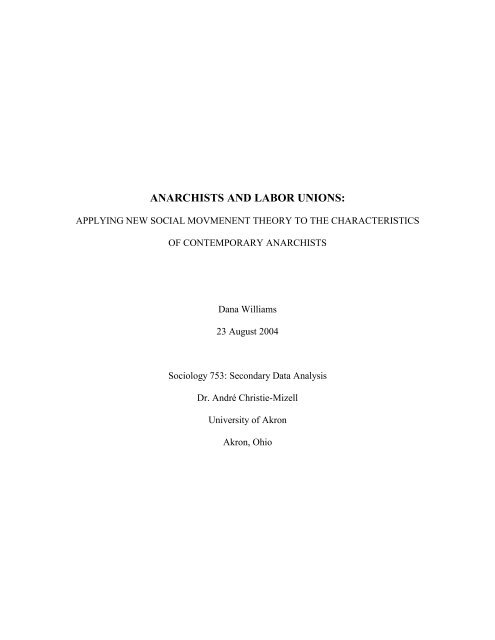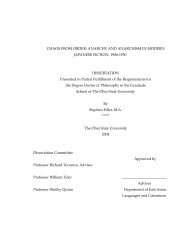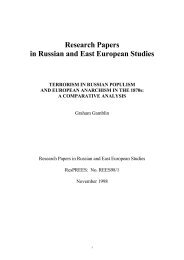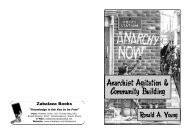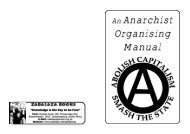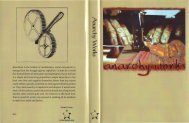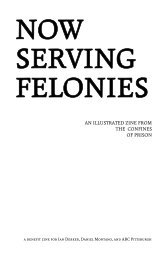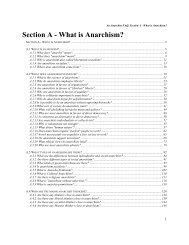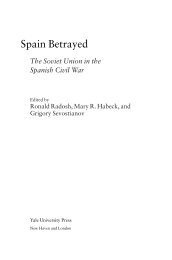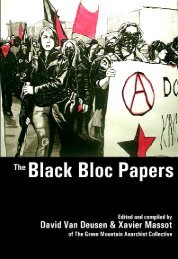Anarchists and Labor Unions - Infoshop.org
Anarchists and Labor Unions - Infoshop.org
Anarchists and Labor Unions - Infoshop.org
You also want an ePaper? Increase the reach of your titles
YUMPU automatically turns print PDFs into web optimized ePapers that Google loves.
ANARCHISTS AND LABOR UNIONS:<br />
APPLYING NEW SOCIAL MOVMENENT THEORY TO THE CHARACTERISTICS<br />
OF CONTEMPORARY ANARCHISTS<br />
Dana Williams<br />
23 August 2004<br />
Sociology 753: Secondary Data Analysis<br />
Dr. André Christie-Mizell<br />
University of Akron<br />
Akron, Ohio
ABSTRACT<br />
This paper studies the characteristics <strong>and</strong> union membership of North American<br />
anarchists. Traditionally, anarchism has been a working-class based movement that<br />
rejects authority <strong>and</strong> domination. New social movement (NSM) theory suggests that<br />
movements have changed in recent decades to focus less on the working class <strong>and</strong><br />
economic issues, <strong>and</strong> more upon social <strong>and</strong> political concerns. A survey by a prominent<br />
anarchist website was analyzed to study if the NSM framework assists in characterizing<br />
the contemporary anarchist movement in North America. Union membership was<br />
positively correlated with four primary explanatory variables: economic ideology,<br />
working class, <strong>and</strong> age. Union membership was negatively correlated with those who do<br />
not want work. Then, survey respondent’s union membership was regressed on those<br />
explanatory variables. With multivariate logistic regression equation, these variables all<br />
remain significant, except for working class, which was no longer significant. North<br />
Americans were also significantly less likely to be unions than those not from North<br />
America. Given these findings, it is questionable how well anarchists are described by<br />
NSM. The association of unions to ideology, class, work, <strong>and</strong> age suggest that anarchists<br />
do participate in economic class <strong>and</strong> labor-related issues. The paper ends by making<br />
suggestions on how to improve upon this research <strong>and</strong> explore other questions regarding<br />
anarchists themselves <strong>and</strong> the anarchist movement.<br />
Keywords: anarchism, labor unions, new social movements.<br />
2
INTRODUCTION<br />
Has the North American anarchist movement changed over time? As a historically<br />
class-oriented movement, are anarchists today less likely to join unions, when considering<br />
their ideology, class, work-focus, <strong>and</strong> age? This paper focuses on these questions <strong>and</strong><br />
asks in what ways these questions apply to a prominent social movement theory.<br />
<strong>Anarchists</strong>, who ascribe to a philosophy that rejects authority <strong>and</strong> domination, are<br />
active in various left-wing movements throughout North America <strong>and</strong> the world. Yet, the<br />
anarchist movement has not been greatly studied, or placed within current social<br />
movement theory. Further quantitative research as to the constitution of the anarchist<br />
movement, its beliefs, <strong>and</strong> current political activities, has been non-existent.<br />
Contemporary social movement theory suggests that the middle-class is the<br />
economic class most directly engaged in social <strong>and</strong> political change activism (Cohen<br />
1985). Further, it is claimed that there is a lack of anarchist participation in unions <strong>and</strong><br />
labor-oriented campaigns, for reasons of differing culture, backgrounds, <strong>org</strong>anizations,<br />
<strong>and</strong> tactics (Sheppard 2002). If anarchism is a new social movement, then an emphasis<br />
upon class <strong>and</strong> labor within traditional social movements (which tend to be working<br />
class) should not be present. In order to explore the above assumptions, the responses to a<br />
user survey of a prominent anarchist website were analyzed.<br />
LITERATURE REVIEW<br />
Anarchism<br />
Anarchism as a social <strong>and</strong> political philosophy has formally been around since the<br />
mid-19 th century, with ideas first expressed by philosophers William Godwin <strong>and</strong> Joseph-<br />
Pierre Proudhon. It is seen as a particular tendency within classical liberalism that seeks<br />
3
the liberation of people from authority <strong>and</strong> domination (Chomsky 1973). Anarchism<br />
advocates the removal of all unnecessary authoritarian <strong>and</strong> hierarchical social institutions<br />
(such as capitalism <strong>and</strong> the centralized nation-state), to be replaced by cooperative,<br />
horizontal, <strong>and</strong> self-empowered relationships (Ward 1996). Although historically lumped<br />
together with communism in terms of highly valuing equality, anarchism rejects state<br />
power (Chirot 1986). As such, anarchists <strong>and</strong> communists have often been at odds with<br />
one another.<br />
<strong>Anarchists</strong> advocate direct action, as opposed to indirect action (such as through<br />
elections) to accomplish the necessary functions of society (de Cleyre 1912). Acting<br />
directly empowers people individually <strong>and</strong> collectively—to both not rely on authority<br />
figures <strong>and</strong> also not to self-restrict oneself to the wishes of those figures, but rather the<br />
need of a given community. In the absence of authority figures, anarchists rely upon<br />
voluntary association with those they choose in order to coordinate their participation in<br />
society (Anarchy FAQ 2004, Ward 1996). <strong>Anarchists</strong> offer mutual aid <strong>and</strong> solidarity to<br />
those who require assistance <strong>and</strong> assume that this will reciprocate to them if the need<br />
arises. Historically, anarchists believe that self-determination is best achieved at smaller<br />
scales, <strong>and</strong> thus often act within small <strong>org</strong>anizations, one being the “affinity group”. In<br />
these anarchist <strong>org</strong>anizations decisions are made by a consensus process or by direct<br />
democracy. More complex forms of <strong>org</strong>anizations are created for broader functions <strong>and</strong><br />
needs, such as collectives, coalitions, federations, <strong>and</strong> spokes-councils (Graeber 2002,<br />
Polletta 2001). The anarchist vision is one of a decentralized world, composed of<br />
interlocking networks <strong>and</strong> federations.<br />
The modern-day anarchist movement is a multi-cause movement that works<br />
towards these ends <strong>and</strong> seeks to interject its radical ideas into other social movements.<br />
4
<strong>Anarchists</strong> have been active in the feminist, civil rights, anti-corporate globalization,<br />
environmental, <strong>and</strong> peace/anti-war movements. Renewed focus upon anarchism as a<br />
radical movement has resurged after the fall of the Soviet Union as a state-based<br />
alternative to capitalism (Day 2003). Increasingly wide-spread use of the Internet has also<br />
increased access to anarchist ideas <strong>and</strong> information, <strong>and</strong> allowed anarchists to<br />
communicate with each other—ironically within a highly anarchistic medium.<br />
Shantz (2003) argues that resistance movements (<strong>and</strong> anarchism in particular) that<br />
want “no part of the world order, new or otherwise” (p. 90) have been neglected by social<br />
movement literature. He argues that most social movement theory studies movements<br />
trying to influence or become part of the existing system as opposed to replacing the<br />
entire order. This shortcoming is important because of heightened participation by<br />
anarchists in recent years in both North America <strong>and</strong> throughout the world, <strong>and</strong> increased<br />
media coverage (Elliott 1999, Kahn 2000) following the anti-World Trade Organization<br />
demonstrations in Seattle during 1999 that anarchists had a large role in planning. As<br />
such, anarchism as both a political tendency <strong>and</strong> as a movement deserves more attention<br />
by sociologists <strong>and</strong> social movement researchers. This paper attempts to begin addressing<br />
this deficit in research.<br />
New Social Movements<br />
North American anarchist <strong>org</strong>anizations, groups that espouse an anarchist<br />
philosophy, may arguably be best understood by Fitzgerald <strong>and</strong> Rodgers’ (2000) model of<br />
radical social movement <strong>org</strong>anizations (RSMOs). Radical <strong>org</strong>anizations differ from<br />
moderate social movement <strong>org</strong>anizations in terms of <strong>org</strong>anizational structure, ideology,<br />
tactics, communication, <strong>and</strong> assessment of success. RSMOs are thus nonhierarchical,<br />
5
participatory, egalitarian, <strong>and</strong> radical, emphasize structural change, <strong>and</strong> use nonviolent<br />
action <strong>and</strong> innovative tactics. According to this model, RSMOs are also ignored <strong>and</strong><br />
misrepresented by the mainstream media, utilize alternative media, use limited resources,<br />
<strong>and</strong> are subject to intense opposition <strong>and</strong> surveillance. This model modifies the<br />
framework set by resource mobilization theory (McCarthy <strong>and</strong> Zald 1977) by arguing that<br />
bureaucratization <strong>and</strong> institutionalization of social movements is not always necessary or<br />
inevitable.<br />
However, for this study, I will use the more widely-known new social movements<br />
(NSM) theory, since it offers the best vantage point to challenge the oft-claimed notion<br />
that the anarchist movement is of the middle-class or that it is not active in class-related<br />
issues. It also speaks more directly to the individual characteristics of movement<br />
participants rather than the <strong>org</strong>anizational structures they utilize.<br />
NSM theory asserts that in this era of post-industrialism, modern social<br />
movements differ from earlier movements, <strong>and</strong> focus upon less-class-oriented issues such<br />
as racial equality, feminism, peace, the environment, <strong>and</strong> localist issues. In North<br />
America, non-class-oriented franchise anarchistic <strong>org</strong>anizations that fall into these<br />
categories include ACT-UP, Anti-Racist Action, Animal Liberation Front, Critical Mass,<br />
Earth First!, Earth Liberation Front, Food Not Bombs, <strong>and</strong> Reclaim the Streets. 1 As such,<br />
Cohen (1985) argues that “Unlike the Old Left, actors involved in contemporary<br />
movements do not view themselves in terms of a socioeconomic class” (p. 667).<br />
1<br />
I’m calling “franchise” anarchist <strong>org</strong>anizations those groups with identical names that exist in multiple<br />
places, <strong>and</strong> have the same general focus <strong>and</strong> purpose. Critical Mass <strong>and</strong> Reclaim the Streets should be<br />
viewed more as events than <strong>org</strong>anizations, since they have no permanent <strong>org</strong>anizational structures to them.<br />
People work loosely with each other during planning, but allow for considerable spontaneity in action <strong>and</strong><br />
statement.<br />
6
Offe (1985) states that NSMs differ from traditional social movements by<br />
focusing on values of autonomy <strong>and</strong> identity, <strong>org</strong>anizing with decentralization, selfgovernment,<br />
<strong>and</strong> self-help in mind, <strong>and</strong> tend to be ad hoc, egalitarian, <strong>and</strong> nonhierarchical—incidentally<br />
strong anarchist values. Because problems related to authority<br />
<strong>and</strong> domination may be found within multiple domains, anarchists are unique in their<br />
relation to NSMs. There is considerable cross-movement participation within all the<br />
aforementioned movements by anarchists <strong>and</strong> their <strong>org</strong>anizations (Epstein 1991, Graeber<br />
2002, Shantz 2003). This varying participation agrees with McCarthy <strong>and</strong> Zald’s (1977)<br />
concept of overlapping social movement “industries”, composed of individual social<br />
movement <strong>org</strong>anizations.<br />
Sheppard (2002) claims, albeit without quantitative analysis, that anarchists are<br />
less likely to <strong>org</strong>anize <strong>and</strong> belong to unions than in the past, <strong>and</strong> that they instead choose<br />
to find other work if their current job is disagreeable. Sheppard hypothesizes this is<br />
because of the aforementioned class collusion of modern unions, macho stereotypes of<br />
unions, <strong>and</strong> the punk subculture of rejection that contemporary anarchism draws heavily<br />
from. He opines that, “Young anarchists often correctly see the <strong>org</strong>anized labor<br />
movement as not radical at all, but as a backwards force embodying the worst kinds of<br />
provincialism <strong>and</strong> political maneuvering” (para. 6). Sheppard’s generalizations appear to<br />
support classifying anarchism within the NSM framework. Cohen (1985) supports this:<br />
“Instead of forming unions or political parties… [NSMs] focus on grass-roots politics <strong>and</strong><br />
create horizontal, directly democratic associations that are loosely federated on national<br />
levels” (p. 667). Albert (2002) also argues that class has disappeared from left-wing<br />
activism, which he attributes to an ill-informed underst<strong>and</strong>ing of class stratification from<br />
7
Marxists <strong>and</strong> the inability of activists to merge a class analysis with feminist <strong>and</strong> antiracist<br />
analysis. 2<br />
Bagguley (1992) is critical of the NSM theory, because the above movements <strong>and</strong><br />
<strong>org</strong>anizational traits existed before the 1960s <strong>and</strong> post-industrialism, thus making a clear<br />
delineation difficult. Pichardo (1997) also criticizes NSM for a number of reasons. He<br />
points out that NSM theory focuses solely on left-wing movements, to the neglect of<br />
right-wing <strong>and</strong> reactionary movements. NSM ideas lack solid empirical evidence <strong>and</strong> as<br />
such tend to be more theoretical. Finally, Pichardo (1997) claims that NSM theory is less<br />
a br<strong>and</strong> new theory than just an addition to social movement theory.<br />
Other Relevant Literature<br />
<strong>Labor</strong> unions are <strong>org</strong>anizations formed at a workplace or in a particular<br />
occupation for the purpose of providing leverage in negotiations with employers over<br />
different aspects of employment, including pay, benefits, <strong>and</strong> working conditions. The<br />
largest union in the United States is the AFL-CIO, a federation of many individual trade<br />
unions. <strong>Unions</strong> have historically been difficult for workers to <strong>org</strong>anize <strong>and</strong> sustain<br />
because of harassment by employers, ranging from repression of union-related speech at<br />
work to firings of union <strong>org</strong>anizers to outright repression by police forces (Brecher 1997).<br />
Robinson (1988) also notes declining <strong>org</strong>anizing efforts of unions themselves <strong>and</strong> the<br />
corporate use of monetary rewards to compete with unions as other reasons for the recent<br />
decline in union membership.<br />
The lack of anarchist participation in unions <strong>and</strong> the labor movement could be<br />
symptomatic of larger trends, such as the move towards a more service-based economy<br />
2<br />
See pages 87-103 for more discussion.<br />
8
<strong>and</strong> the widespread creation of “McJobs” (Klein 1999, Schlosser 2002). Relatedly, there<br />
has been a steady decline in union membership in the US during the last two decades<br />
(Bureau of <strong>Labor</strong> Statistics 2004). In response, Sheppard <strong>and</strong> others (Chomsky 1973,<br />
Dolgoff 1977) advocate a direct engagement with the labor movement, potentially along<br />
the lines of anarcho-syndicalism <strong>and</strong> radical trade unions (like the Industrial Workers of<br />
the World, or IWW), or participation in wholly-owned worker cooperatives (as detailed<br />
in Rothschild-Whitt 1979).<br />
The anarchist movement is far more diverse than it was a century ago, when its<br />
primary focus was economic. It has ideologically branched out into other issues not<br />
widely part of social movements at the time. This new diversity can be seen in how<br />
anarchists sometimes identify with particular strains or tendencies, often noted in the<br />
prefix or suffix applied to their ideology. People who call themselves social anarchists<br />
focus on general social injustices <strong>and</strong> hierarchy. Anarcha-feminists deal with genderrelated<br />
issues, such as reproductive choice, domestic violence, <strong>and</strong> forms of patriarchic<br />
domination. Eco-anarchists emphasize a t<strong>and</strong>em focus upon environmental defense (of<br />
places such as old-growth forests), <strong>and</strong> protest of corporate <strong>and</strong> government destruction<br />
of the environment. Anarcho-communists emphasize egalitarian, communist values such<br />
as producer <strong>and</strong> consumer cooperatives <strong>and</strong> collective ownership. Finally, anarchosyndicalists<br />
advocate worker control over the means of production at the workplace, often<br />
practiced in the form of radical unionism.<br />
It may be assumed that if one bothers to claim a specific orientation as those<br />
mentioned above, that such a decision reflects the tendency towards certain actions. For<br />
example, those with an anarcho-syndicalist focus may be more likely to join <strong>and</strong> <strong>org</strong>anize<br />
labor unions. Yet, there are also those who identify as “anarchists without adjectives”,<br />
9
which signifies a tolerance for all the various strains (Nettlau 1996). Although seemingly<br />
disparate in nature, all the aforementioned strains are linked by a common rejection of<br />
hierarchical authority <strong>and</strong> domination, <strong>and</strong> the desire to address society’s problems in a<br />
fashion that allows for self-determination <strong>and</strong> cooperation.<br />
Modern anarchists <strong>and</strong> radical Marxists (DeLeon 1996, Meltzer 1996, Pannekoek<br />
2003) have typically—<strong>and</strong> cynically—characterized modern trade unions as “class<br />
traitors”, noting union leadership’s collusion with large corporations against workers’<br />
class interests. This analysis is also found in Marxism (Robinson 1988). This<br />
characterization is always followed by a disclaimer noting that unions themselves are not<br />
the problem, just the bureaucratic <strong>and</strong> hierarchical way in which many are run. This<br />
analysis of unions is particularly relevant due to anarchism’s central place within the<br />
labor movement during the late 19 th <strong>and</strong> early 20 th centuries, <strong>and</strong> the importance placed<br />
upon working class <strong>org</strong>anizing (Berkman 2003, Brecher 1997, Goldman 1970, Rocker<br />
1990). The IWW, for instance, was a major force in US labor history, helping to unite<br />
Native-born <strong>and</strong> immigrant workers in a wide-range of industries into “One Big Union”<br />
that thus wielded incredible clout.<br />
There are contemporary anarchists who <strong>org</strong>anize with class in mind (particularly<br />
with the working class), such as the IWW in the US <strong>and</strong> the Class War Federation of<br />
Great Britain (Class War Federation 1992).<br />
The counter-perspective within anarchism is best illustrated by the writings of the<br />
CrimethInc Ex-Workers Collective (2000). This activist collective publishes inexpensive<br />
<strong>and</strong> widely-read propag<strong>and</strong>a for the anarchist movement. CrimethInc’s writings are the<br />
work of multiple individuals <strong>and</strong> thus offer varying opinions on the subjects discussed.<br />
The group’s main goal is to inspire readers to take more active control of their own lives.<br />
10
Their suggested method for battling capitalism <strong>and</strong> its entrenched corporate power<br />
structure is to evade participation in it at all. Instead they aim to live free of wage slavery<br />
<strong>and</strong> to survive off the excesses of capitalism, in order to provide resources for fighting<br />
against authority. Frequent suggestions for this include, but are not limited to, scamming,<br />
theft, <strong>and</strong> dumpstering.<br />
CrimethInc does not advocate participation in unions or other forms of classbased<br />
<strong>org</strong>anizing, nor does it explicitly encourage working at actual, so-called normal<br />
jobs. Bookchin (1995) calls this perspective “lifestyle anarchism”. The writings of Black<br />
(1985) <strong>and</strong> Zerzan (1994) have been influential to this “no work” attitude, in the former’s<br />
call to “abolish work” <strong>and</strong> that latter’s desire to “end civilization” itself. Even though<br />
CrimethInc has a , particular anti-work tendency, it usually reserves its harshest criticism<br />
for mind <strong>and</strong> body numbing labor. CrimethInc makes a thoughtful critique of capitalism<br />
<strong>and</strong> passionate call for personal liberation from it. CrimethInc is relatively new, thus<br />
many of its adherents are likely younger anarchists.<br />
<strong>Anarchists</strong> are commonly portrayed as younger than the general population—or so<br />
asserts the media stereotype of the rebelling teenager. Some argue that these people are<br />
more idealistic in their youth (Mead 1974), while other studies (Fendrich <strong>and</strong> Turner<br />
1989) have shown the opposite affect, as activists politically mature with age <strong>and</strong> become<br />
more active. In addition to these maturation affects, there can be generational differences,<br />
as the interests, focuses, <strong>and</strong> activities of certain age groups in various eras.<br />
The Bureau of <strong>Labor</strong> Statistics (2004) concluded that workers in 2003 aged 16-24<br />
had the lowest levels of union membership (5.1 percent), even lower than workers 65 <strong>and</strong><br />
over. The workers with the highest percentage of membership were aged 45-54 (17.6).<br />
11
Lower age workers have low union membership, in part, due to the low-levels of<br />
unionization in low-paid entry jobs frequently held by youth.<br />
Whites in the US had the second highest percentage of union membership after<br />
African-Americans (Bureau of <strong>Labor</strong> Statistics 2004). In 2003, 16.5 percent of all<br />
employed African-Americans were in unions, while 12.5 percent of Whites were in<br />
unions. The Bureau also notes that males are more likely to be in unions than females.<br />
For those workers 16 years old <strong>and</strong> over, 14.3 percent of men <strong>and</strong> 11.4 percent of women<br />
are union members.<br />
Lesbian <strong>and</strong> gay labor activists “have long seen themselves as a bridge between<br />
two natural allies” (Bain 1999, 58). Grevatt (2001) likewise argues that the lesbian, gay,<br />
bisexual, <strong>and</strong> transgender (LGBT) movement is solidly rooted in the working class, <strong>and</strong><br />
points towards the Pride At Work constituency group within the AFL-CIO as a good<br />
example LGBT <strong>org</strong>anizing within the labor movement. Yet, Humphrey (1999) found<br />
little union support in a study of lesbians <strong>and</strong> gays in public service occupations, despite<br />
the official recognition by the union of the discrimination some faced for their sexual<br />
orientation. Homosexual union members self-<strong>org</strong>anized within the union, constituting an<br />
important committee.<br />
Historically, many anarchists have rejected <strong>org</strong>anized religion, particularly<br />
hierarchical religions like Catholicism (Bakunin 1970, Goldman 2001). The strongest<br />
proponents of atheism within anarchism have themselves been working class union<br />
<strong>org</strong>anizers. Still, some anarchists remain religious or spiritual; Leo Tolstoy <strong>and</strong> the<br />
Catholic Worker movement are primary examples of Christian anarchists. There are also<br />
differences in the tendency to unionize based upon religious affiliation. A study<br />
12
conducted by Misra <strong>and</strong> Hicks (1994) found that Catholics in affluent democracies—as<br />
those in Canada <strong>and</strong> the US—have on average not unionized at the rate of non-Catholics.<br />
Union membership in the US is relatively low compared to other industrialized<br />
countries such as in Western Europe. For example, British union membership was until<br />
recently 50 percent of the working population (Heery, et al. 2002). Although in decline,<br />
British membership still remains higher than in the US, where union members constitute<br />
just under 13 percent of the labor force (Bureau of <strong>Labor</strong> Statistics 2004).<br />
SUMMARY AND HYPOTHESES<br />
This work posits anarchism within a new social movement theory framework. It<br />
begins to create a rudimentary analysis of the North American anarchists <strong>and</strong> their various<br />
qualities <strong>and</strong> attitudes, analysis that till present has been severely lacking.<br />
In this research I hypothesize that:<br />
H1: Working class anarchists tend to belong to unions;<br />
H2: <strong>Anarchists</strong> with an economic ideology tend to belong to unions;<br />
H3: Anti-work beliefs <strong>and</strong> practices tend to deter membership in unions;<br />
H4: Older age is a strong predictor of union membership, therefore:<br />
H5: <strong>Anarchists</strong> do not fit neatly within NSM theory, although they share some<br />
sympathetic tendencies.<br />
Sample<br />
DATA AND METHODS<br />
13
For this study, data we extracted from a 2002 user survey of the prominent North<br />
American anarchist website www.infoshop.<strong>org</strong>, the Mid-Atlantic <strong>Infoshop</strong> (herein called<br />
“<strong>Infoshop</strong>”). Previous mass media research has shown that <strong>Infoshop</strong> is an online nexus<br />
for anarchist information (<strong>and</strong> “counter-propag<strong>and</strong>a”) <strong>and</strong> other anarchist websites<br />
(Owens <strong>and</strong> Palmer 2003). The survey includes 922 responses.<br />
The survey was posted on a single webpage, linked from the site’s homepage. It<br />
consisted of nineteen personal <strong>and</strong> demographic questions, thirteen questions about<br />
politics, eight questions about activism, fifteen questions about the <strong>Infoshop</strong> webpage,<br />
<strong>and</strong> ten other questions about “other stuff”. The questions commonly offered only fixedresponse<br />
answers, although the survey would sometimes offer the opportunity to specify<br />
an “other” response. Anyone – not just anarchists – who visited the webpage could take<br />
the survey, there was no time limit, <strong>and</strong> it was only offered in English.<br />
A “digital divide” bias might be found in internet-based surveys. A National<br />
Telecommunications <strong>and</strong> Information Administration study (2002) shows that Whites <strong>and</strong><br />
Asian-Americans, the more affluent, <strong>and</strong> more educated tend to use computers <strong>and</strong> the<br />
internet more than other race/ethnic groups, the less affluent, <strong>and</strong> less educated. Roughly<br />
equal numbers of men <strong>and</strong> women use the internet. Seventy-five percent of respondents<br />
were male <strong>and</strong> one-third of respondents described their economic background as<br />
“working class”. In terms of gender <strong>and</strong> class, the <strong>Infoshop</strong> survey is an atypical sample<br />
of respondents for internet users.<br />
The respondents form a group that is really part of only one generation (late teens<br />
to middle twenties), <strong>and</strong> that a minority of middle-age <strong>and</strong> older respondents skew the<br />
mean age to appear older than one might expect at first glance. The relative youthfulness<br />
of survey respondents should caution the reader. And as evidenced by the Bureau of<br />
14
<strong>Labor</strong> Statistics’ (2004) study, this age group also tends to have the lowest union<br />
membership.<br />
Measures<br />
Dependent variable. The outcome measure for this study is union membership.<br />
User responses were dummy-coded to true or false for each possible response; thus if a<br />
respondent is in a union, s/he is assigned a 1 value (true), or a 0 value (false) if not a<br />
union member. Respondents who answered affirmative to the union question in the<br />
<strong>Infoshop</strong> survey are compared to those who report not belonging to a union.<br />
Explanatory <strong>and</strong> Control Variables. Also dummy-coded are the following<br />
explanatory, independent variables. The variable “economic anarchist” is created from the<br />
two responses to political ideology that are both economic <strong>and</strong> anarchist in focus<br />
“anarcho-communist” <strong>and</strong> “anarcho-syndicalist” (1=yes). These two ideologies<br />
emphasize the importance of attention to class <strong>and</strong> economic issues. All other responses<br />
to ideology were dummy-coded as 0=no, including regular anarchists. Those who simply<br />
called themselves anarchists might sympathize with the same values as economic<br />
anarchists or may also call themselves such, but they are still dummy-coded 0 as<br />
economic anarchists in this study.<br />
Working class (responses to economic background, includes “dirt poor” <strong>and</strong><br />
“working class, blue/pink/white collar”; 1=yes), while 0=no <strong>and</strong> includes both middle<strong>and</strong><br />
upper-class respondents; Those who don’t want work (responses to work, includes<br />
“never”, “Crimethinc”, <strong>and</strong> “government h<strong>and</strong>outs”; 1=yes), while the omitted categories<br />
include those who work full- <strong>and</strong> part-time, are students, or are currently unemployed.<br />
Age is a continuous variable measured in years.<br />
15
I controlled for other st<strong>and</strong>ard demographic variables, including: White (response<br />
to race; 1=yes), while 0 includes Asian, African-American, Latino, indigenous, <strong>and</strong><br />
mixed; male (response to gender; 1=yes), while 0 includes female <strong>and</strong> transgender/other;<br />
heterosexual (response to sexual orientation; 1=yes), while 0 includes gay, lesbian,<br />
bisexual, transgender, <strong>and</strong> “gender-queer”; no religion (responses to religion, includes<br />
“agnostic”, “atheist”, <strong>and</strong> “not religious”; 1=yes), while 0 includes both mono- <strong>and</strong> polytheistic<br />
religions, <strong>and</strong> other spiritual philosophies (such as Taoism <strong>and</strong> Church of the<br />
SubGenius); North America (responses to country of residence, includes “Canada”,<br />
“Mexico”, <strong>and</strong> “United States”; 1=yes). Dummy-coded as 0 are all others, who are<br />
predominantly European. The label “North American” might be slightly misleading, since<br />
although Mexicans are counted, they are very few in number. They are included since I<br />
assume that the proximity to the US <strong>and</strong> other possible cultural similarities makes these<br />
respondents analogous to other North Americans (O’Connor 2003), despite the language<br />
difference (<strong>Infoshop</strong> is written overwhelmingly in English).<br />
Analytic Strategy<br />
The core of my analysis is to see how union members are associated with the<br />
working class <strong>and</strong> economic anarchists, holding constant work <strong>and</strong> age. The predictive<br />
diagram for this research is as follows:<br />
I use logistic regression analysis, since the dependent variable is binary (1 = union<br />
membership). The independent variables of the regression model also include basic sociodemographic<br />
variables (such as race/ethnicity, gender, sexuality, religious affiliation,<br />
place of origins). I use progressive adjustment models (Stolzenberg 1980) in three steps.<br />
First, I regress the dependent variable on the control variables. This step allows analysis<br />
16
of the relationship between union membership <strong>and</strong> the general demographic traits of<br />
survey respondents. Secondly, only the independent variables that measure anarchism are<br />
regressed. This step shows the relationship between the variables which should directly<br />
predict union membership. Third, I regress the dependent variable on all variables, both<br />
the independent <strong>and</strong> control variables.<br />
This process shows how the independent variables of both Models 1 <strong>and</strong> 2 affect<br />
the dependent variable, <strong>and</strong> then how each set affects each other when combined together<br />
in Model 3. If the variables were never split-up in smaller groups, it would be difficult to<br />
know what affect the groups have separately.<br />
RESULTS<br />
Descriptive findings<br />
Table 1 shows the descriptive statistics <strong>and</strong> correlations for all the variables in this<br />
study. Nineteen percent (170 people) of those who answered the question stated they<br />
belonged to a union. Although this percentage may seem higher than US figures for union<br />
membership, remember that this number is inflated by non-US respondents (only 16<br />
percent of US respondents were in a union). People who specified an economic anarchist<br />
ideology (anarcho-communist or anarcho-syndicalist) accounted for 14 percent of<br />
responses. There may be far more who would identify or sympathize with these<br />
ideologies, yet chose to respond simply with a fundamental answer of “anarchist” (23<br />
percent did). One-third of respondents placed their economic background in the working<br />
class, while six percent professed a CrimethInc or other don’t want work attitude.<br />
[ TABLE 1 ABOUT HERE ]<br />
17
The average age was 24 years old. Age is a particularly important variable to the<br />
study, yet as mentioned earlier the low average age should caution the reader to<br />
conclusions drawn by the age variable. The range is from twelve to 65, <strong>and</strong> more than<br />
half the respondents were between the ages of 18 <strong>and</strong> 25.<br />
<strong>Anarchists</strong> in the <strong>Infoshop</strong> survey differ from the general population in a number<br />
of other key ways—gender (75 percent male), sexual orientation (only 68 percent<br />
heterosexual), <strong>and</strong> religion (65 percent not religious). Eighty-two percent identified as<br />
White <strong>and</strong> eighty-five percent were from North America.<br />
Union membership is correlated with all four of the predictive independent<br />
variables (economic anarchist, working class, don’t want work, <strong>and</strong> age), as well as the<br />
North American control variable. Three of these variables are positively correlated to<br />
unions: economic anarchists (r=.191, p
White (r=.071, p=.047), male (r=.101, p=.003), <strong>and</strong> heterosexual (r=.092, p=.008), <strong>and</strong><br />
also negatively correlated to North American (r=-.109, p=.001).<br />
Multivariate findings<br />
Table 2 displays findings from the logistic regression analysis. Model 1 shows<br />
union membership (1=yes) regressed on the control variables. North Americans (1=yes)<br />
are less likely, compared to their counterparts (predominantly European) to be union<br />
members. In fact, being North American reduces the probability that the respondent will<br />
belong to a union by about 50 percent [(e -.704 – 1) × 100]. None of the other control<br />
variables are significant.<br />
[ TABLE 2 ABOUT HERE ]<br />
In Table 2, Model 2, union membership is regressed on the independent measures<br />
for this study. Being an economic anarchist compared all other ideological focuses<br />
increases the probability of belonging to a union by more than 210 percent [(e 1.136 - 1) ×<br />
100]. Those who don’t want work, when compared to all those who do work, are 92<br />
percent less likely to be in unions [(e -2.528 – 1) × 100]. They also have the largest absolute<br />
regression coefficient in Model 2. Finally, age increases the likelihood of being in a union<br />
by six percent [(e .062 – 1) × 100]. Although expected to predict union membership, having<br />
a working class background was not significant in Model 2.<br />
Table 2, Model 3 represents the final model for this study. Union membership is<br />
regressed on both the explanatory <strong>and</strong> control variables. The same variables stay<br />
significant as in Models 1 <strong>and</strong> 2. Being an economic anarchists compared to other<br />
19
ideologies increases the probability of being in a union by nearly 260 percent [(e 1.275 – 1)<br />
× 100], an increase of 46 percent once the control variables are added into the model. The<br />
other variables do not change as greatly. Not wanting work , when compared to others<br />
who work, decreases the likelihood of being in a union by 90 percent [(e-2.352 – 1) ×<br />
100], a two percent increase once the controls are added. The influence of the variable<br />
age on union membership in Model 3 is the same as in Model 2. Age increases the<br />
probability of being in a union by six percent [(e .062 – 1) × 100]. North Americans are 47<br />
percent [(e -.761 – 1) × 100] less likely to be in unions, compared to those not from North<br />
America, a three percent change compared to Model 1, which included only control<br />
variables.<br />
DISCUSSION <strong>and</strong> CONCLUSIONS<br />
Union membership of <strong>Infoshop</strong> respondents in the US (16.4 percent) was<br />
marginally higher than in the general population. This unionization level is half that of<br />
respondents from Europe (35.3 percent). NSM applies to developed Western nations<br />
generally, <strong>and</strong> thus the higher European membership rate should be included when<br />
considering anarchism <strong>and</strong> NSMs. This suggests that other regions may deviate from the<br />
NSM framework more clearly than North Americans. However, since this paper centered<br />
upon North America I focused on anarchists in that region, whom were only slightly more<br />
likely to be in a labor union than their mainstream fellow citizens. The percentage of<br />
union members may be noticeably larger if the “don’t want work” respondents are<br />
removed from the analysis, as non-workers are removed from Census Bureau analysis of<br />
union membership (BLS 2004).<br />
20
Both the bivariate <strong>and</strong> multivariate findings generally support H1, that one’s<br />
political ideology—particularly the emphasis upon economics—influence membership in<br />
unions. If an individual is concerned enough to identify specifically as anarcho-syndicalist<br />
or anarcho-communist, as opposed to just an anarchist, this commitment seems to<br />
translate into carrying out that “class struggle” ideology into action. The regression<br />
coefficient increased as the control variables were inserted, becoming a stronger<br />
relationship.<br />
Although working class is significantly related to union membership, when<br />
evaluated by multivariate analysis, its importance diminishes. Consequently, the impact<br />
of other independent variables lessen the impact that working class has for predicting<br />
union membership. This weakens the conclusion related to H2.<br />
In addressing H3, work appears to play a role in influencing union membership.<br />
Those who “don’t want work”, although negatively predictive of union membership,<br />
constitute a very small percentage of the overall sample (5.5 percent of respondents) <strong>and</strong><br />
consequently the coefficient has a large st<strong>and</strong>ard error (1.027). Still, the overall result is<br />
as expected—those with don’t want work attitudes <strong>and</strong> behaviors would not be part of<br />
unions. This attitude is clearly not very pervasive in the movement, although the <strong>Infoshop</strong><br />
survey did not directly ask respondents if they shared an affinity for it.<br />
The don’t want work attitude <strong>and</strong> CrimethInc perspective has a distinct lifestyle<br />
behind it, one that is not conducive to <strong>org</strong>anizing, participation in, or even basic sympathy<br />
with unions. These people provide a strong case against H5—which predicts that<br />
anarchists do not fit the NSM framework—by showing that they are unlikely to belong to<br />
unions.<br />
21
Older anarchists have a higher likelihood of union membership than younger<br />
anarchists. On the surface, this would suggest support for H4. The sample includes<br />
respondents who are minors <strong>and</strong> may be one explanatory factor. 3 This finding may also be<br />
partially explained by the need for security that increases with age. The need for security<br />
tends to lead people to find stable work, which can often be found within labor unions.<br />
Finally, since the st<strong>and</strong>ard deviation of respondents to age is roughly 8 years (above or<br />
below 24), the survey is not really multi-generational.<br />
The only significant control variable from Model 3 is North Americans, who tend<br />
toward non-membership in unions. Since three-fifths of the non-North Americans are<br />
Europeans, this suggests varying attitudes across the Atlantic Ocean. The other controls—<br />
Whites, males, heterosexuals, <strong>and</strong> the non-religious—are not significant, nor are they<br />
correlated with membership.<br />
This paper has begun the task of creating quantitative research looking at North<br />
American anarchists. It has sought to address the assumptions of anarchists as<br />
participants in a middle-class movement, as is the case with NSMs generally. The<br />
regression model generated successfully addressed the first four hypotheses, with the<br />
exception of H2.<br />
It is clear that when anarchists identify specifically with an economic ideology<br />
they are more likely to belong to labor unions. What’s not clear is that these anarchists<br />
come from the working class (at least at a multivariate level). The working class is very<br />
present within the anarchist movement. But this background does not predict union<br />
membership within the full regression model, despite being significantly correlated. The<br />
3 There is a strong negative relationship (r = -.314, p = .000) between the age of recipient <strong>and</strong> if they were a<br />
student who does not work, more than half of whom are 18 or under. One-tenth of overall respondents were<br />
both minors <strong>and</strong> students that didn’t work (thus could not be part of a union). This obviously influences the<br />
work <strong>and</strong> possibly the political ideology of respondents.<br />
22
countervailing trend—although far less common amongst anarchists—is the influence of<br />
the CrimethInc work ideology in which anarchists are far less likely to be in unions. Older<br />
anarchists are more likely to belong to unions, yet this point should be viewed as<br />
inconclusive due to the small range of age in the <strong>Infoshop</strong> dataset. North Americans tend<br />
not to belong to unions compared to others throughout the world.<br />
In addressing H5, it is unclear if anarchists may be placed within the NSM<br />
framework or not. If the results for H2 were more conclusive, it would be easier to do so.<br />
Generally, the results suggest that anarchists are not apart of NSMs, for the simple fact<br />
that of high working class response to the <strong>Infoshop</strong> survey, while NSM asserts that<br />
movements are primarily composed of elements of the middle class. Yet, the nonsignificant<br />
tendency for the working class to participate in unions (the best counterexample<br />
to NSM in this study) makes this point unclear.<br />
It should be noted that although this research has tested the characteristics of<br />
anarchists who do or do not belong to labor unions, this does not suggest anything beyond<br />
that. Active participation, <strong>org</strong>anizing, or activism is unknown for these individuals. Since<br />
NSM theory suggests that traditional movements were active labor <strong>and</strong> class-based<br />
movements, it is not possible to claim that simple membership to a union constitutes a<br />
labor movement.<br />
While it is generally clear that the focus <strong>and</strong> composition of anarchists themselves<br />
have changed from earlier generations, it is less clear how the anarchist movement itself<br />
has changed. <strong>Anarchists</strong> appear to be embracing a broader philosophy <strong>and</strong> issue-focus<br />
than in the past. Does this suggest that anarchists belong to NSMs? Or, if the picture is<br />
less clear, does it merely support part of the NSM theory, yet not others?<br />
23
The values of NSMs are very anarchistic; values such as autonomy, selfdetermination,<br />
<strong>and</strong> decentralization are professed as core values in anarchist literature.<br />
Bagguley (1992) notes that these are not necessarily new tendencies, which is true for the<br />
anarchist movement; classic anarchist theorists (like Proudhon <strong>and</strong> Bakunin) wrote about<br />
these values well before sociology itself became a discipline. Yet, this paper did not test<br />
anarchist values <strong>and</strong> attitudes, so a comparison based upon these criteria is not possible. It<br />
is difficult to answer these large questions with just one survey, especially a limited one.<br />
Future research should consider the philosophical <strong>and</strong> real support of unions as<br />
part of anarchist ideology, not just that which is economic in focus. It may be that<br />
“anarchists without adjective” are equally likely to participate in unions as their<br />
economic-focused counterparts, yet this is impossible to tell from the <strong>Infoshop</strong> survey<br />
results. Questions that exp<strong>and</strong> on simple union membership, such as activity within a<br />
union or union-<strong>org</strong>anizing itself, would be useful.<br />
<strong>Unions</strong> are not the only working class or economic-focused <strong>org</strong>anizations that<br />
exist, but they are the most prevalent <strong>and</strong> prominent. Future research should look for<br />
other <strong>org</strong>anizations that derive from the working class or focus on economic issues.<br />
Anarchist participation in such <strong>org</strong>anizations may be different than membership in labor<br />
unions. This would strengthen the confidence that other possible structures of traditional<br />
movements are being studied, not just unions.<br />
Using a different measure for class, such as annual income, may provide a<br />
different result than the question used by the <strong>Infoshop</strong> survey to illicit economic class<br />
background. The ability to separate certain sectors of the middle-class—service sector<br />
workers, non-profit workers, students, <strong>and</strong> retirees—would aid in testing who in the<br />
middle class is supportive of the anarchist movement according to NSM. Asking for<br />
24
educational status would facilitate analysis of the “traditional intellectual” position of the<br />
middle class in NSM theory. Finally, efforts to seek out anarchists of older generations to<br />
test the impact of age upon union membership would help provide a richer context.<br />
More importantly, future research may wish to seek a better way to explore the<br />
ideology versus identity question proposed by NSM. One possible way is to evaluate<br />
anarchist beliefs in NSM values, tactics, <strong>and</strong> focus. In doing so, it would be possible to<br />
apply these elements to the RSMO theory discussed earlier, allowing a contrast between<br />
the two frameworks.<br />
Finally, differentiating between anarchists <strong>and</strong> participants in an anarchist<br />
movement <strong>and</strong> being able study them, their actions, <strong>and</strong> their beliefs over time will be the<br />
key in being able to analyze the anarchist movement itself, as opposed to merely the<br />
characteristics of individual anarchists. This will help deal with the question of causality<br />
with who is part of a union, <strong>and</strong> if that membership is possibly a deliberate choice <strong>and</strong> not<br />
just a requirement for their job.<br />
25
REFERENCES<br />
Albert, Michael. 2002. The Trajectory of Change: Activist Strategies for Social<br />
Transformation. Cambridge, MA: South End Press.<br />
Anarchy FAQ. 2004. An Anarchist FAQ. Version 10.0. http://www.anarchyfaq.<strong>org</strong>.<br />
Bagguley, Paul. 1992. “Social Change, the Middle Class <strong>and</strong> the Emergence of ‘New Social<br />
Movements’: A Critical Analysis”. The Sociological Review, 40 (1), February: 26-48.<br />
Bain, Christian Arthur. 1999. “A Short History of Lesbian <strong>and</strong> Gay <strong>Labor</strong> Activism in the<br />
United States”. Pp. 58-86 in <strong>Labor</strong>ing for Rights: <strong>Unions</strong> <strong>and</strong> Sexual Diversity Across<br />
Nations, edited by G. Hunt. Philadelphia: Temple University Press.<br />
Bakunin, Michael. [1916] 1970. God <strong>and</strong> The State. New York: Dover. Originally from a<br />
French translation.<br />
Berkman, Alex<strong>and</strong>er. [1937] 2003. What is Anarchism?. Edinburgh: AK Press.<br />
Black, Bob. 1985. The Abolition of Work <strong>and</strong> Other Essays. Port Townsend, WA:<br />
Loopmaniacs.<br />
Bookchin, Murray. 1995. Social Anarchism or Lifestyle Anarchism: An Unbridgeable<br />
Chasm. Edinburgh: AK Press.<br />
Brecher, Jeremy. 1997. Strike! Cambridge, MA: South End Press.<br />
Bureau of <strong>Labor</strong> Statistics. 2004. Union Members in 2003. Press release. January 21.<br />
http://www.bls.gov/news.release/pdf/union2.pdf<br />
Chirot, Daniel. 1986. Social Change in the Modern Era. San Diego: Harcourt Brace<br />
Jovanovich.<br />
Chomsky, Noam. 1973. For Reasons of State. New York: Pantheon.<br />
26
Class War Federation. 1992. Unfinished Business: The Politics of Class War. Edinburgh: AK<br />
Press.<br />
Cohen, Jean L. 1985. “Strategy or Identity: New Theoretical Paradigms <strong>and</strong> Contemporary<br />
Social Movements”. Social Research, 52 (4): 663-716.<br />
CrimethInc. 2000. Days of War, Nights of Love. Atlanta: Crimethinc.<br />
Day, Christopher. [1994] 2003. “Love <strong>and</strong> Rage in the New World Order”. Pp. 55-64 in A<br />
New World in Our Hearts: Eight Years of Writings from the Love <strong>and</strong> Rage<br />
Revolutionary Anarchist Federation, edited by R. San Filippo. Oakl<strong>and</strong>: AK Press.<br />
de Cleyre, Voltairine. 1912. Direct Action. New York: Mother Earth.<br />
DeLeon, David. 1996. “For Democracy Where We Work: A Rationale for Social Self-<br />
Management”. Pp. 192-210 in Reinventing Anarchy, Again, edited by H. J. Ehrlich.<br />
Edinburgh: AK Press.<br />
Dolgoff, Sam. 1977. The Relevance of Anarchism to Modern Society. Minneapolis: Soil of<br />
Liberty.<br />
Elliott, Michael. 1999. “The New Radicals”. Newsweek, December 13: 36-39.<br />
Epstein, Barbara. 1991. Political Protest <strong>and</strong> Cultural Revolution. Berkeley, CA: University<br />
of California Press.<br />
Fendrick, James Max <strong>and</strong> Robert W. Turner. 1989. “The Transition from Student to Adult<br />
Politics”. Social Forces, 67 (4), June: 1049-1057.<br />
Fitzgerald, Kathleen J. <strong>and</strong> Diane M. Rodgers. 2000. “Radical Social Movement<br />
Organizations: A Theoretical Model”. The Sociological Quarterly, 41 (4): 573-592.<br />
Goldman, Emma. 1970. Living My Life. Volumes 1 <strong>and</strong> 2. New York: Dover.<br />
27
Goldman, Emma. [1916] 2001. “The Philosophy of Atheism”. Pp. 88-93 in Anarchy! An<br />
Anthology of Emma Goldman’s Mother Earth, edited by P. Glassgold. Washington, D.C.:<br />
Counterpoint.<br />
Graeber, David. 2002. “The New <strong>Anarchists</strong>”. New Left Review, 13, Jan/Feb: 61-73.<br />
Grevatt, Martha. 2001. “Lesbian/Gay/Bisexual/Transgender Liberation: What’s <strong>Labor</strong> Got to<br />
Do With It?”. Social Policy, 31 (3), Spring: 63-65.<br />
Heery, Ed, John Kelly, Jeremy Waddington. 2002. “Union Revitalization in the United<br />
Kingdom”. International Institute for <strong>Labor</strong> Studies: DP/133/2002.<br />
http://www.ilo.<strong>org</strong>/public/english/bureau/inst/download/dp13302.pdf<br />
Humphrey, Jill C. 1999. “Organizing Sexualities, Organized Inequalities: Lesbians <strong>and</strong> Gay<br />
Men in Public Service Occupations”. Gender, Work <strong>and</strong> Organization, 6 (3), July: 134-<br />
151.<br />
Kahn, Joseph. 2000. “Anarchism, the Creed That Won't Stay Dead”. New York Times,<br />
August 5.<br />
Klein, Naomi. 1999. No Logo: No Space, No Jobs, No Choice. New York: Picador.<br />
McCarthy, John D. <strong>and</strong> Mayer Zald. 1977. “Resource Mobilization <strong>and</strong> Social Movements:<br />
A Partial Theory”. American Journal of Sociology, 82 (6): 1212-1241.<br />
Mead, Margaret. 1974. “Youth Would Be Valiant”. Education, 94 (4), April/May: 376-379.<br />
Meltzer, Albert. 1996. Anarchism: Arguments For <strong>and</strong> Against. Edinburgh: AK Press.<br />
Misra, Joya <strong>and</strong> Alex<strong>and</strong>er Hicks. 1994. “Catholicism <strong>and</strong> Unionization in Affluent Postwar<br />
Democracies: Catholicism, Culture, Party, <strong>and</strong> Unionization”. American Sociological<br />
Review, 59 (2), April: 304-326.<br />
National Telecommunications <strong>and</strong> Information Administration. 2002. “A Nation Online:<br />
How Americans Are Exp<strong>and</strong>ing Their Use of the Internet”. Washington, DC: US<br />
28
Department of Commerce, February.<br />
http://www.ntia.doc.gov/ntiahome/dn/nationonline_020502.htm.<br />
Nettlau, Max. 1996. A Short History of Anarchism. London: Freedom Press.<br />
O'Connor, Alan. 2003. “Punk Subculture in Mexico <strong>and</strong> the Anti-globalization Movement: A<br />
Report from the Front”. New Political Science, 25 (1): 43-53.<br />
Offe, Claus. 1985. “New Social Movements: Challenging the Boundaries of Institutional<br />
Politics”. Social Research, 52 (4): 817- 868.<br />
Owens, Lynn <strong>and</strong> L. Kendall Palmer. 2003. “Making the News: Anarchist Counter-Public<br />
Relations on the World Wide Web”. Critical Studies in Media Communication, 20 (4),<br />
December: 335-361.<br />
Pannekoek, Anton. [1948] 2003. Workers’ Councils. Oakl<strong>and</strong>: AK Press.<br />
Pichardo, Nelson A. 1997. “New Social Movements: A Critical Review”. Annual Review of<br />
Sociology, 23 (1): 411-430.<br />
Polletta, Francesca. 2001. “'This is What Democracy Looks Like': A Conversation with<br />
Direct Action Network Activists David Graeber, Brooke Lehman, Jose Lugo, <strong>and</strong> Jeremy<br />
Varon”. Social Policy, 31 (4), Summer: 25-30.<br />
Robinson, J. Gregg. 1988. “American <strong>Unions</strong> in Decline: Problems <strong>and</strong> Prospects”. Critical<br />
Sociology, 15 (1), Spring: 33-56.<br />
Rocker, Rudolf. [1938] 1990. Anarcho-Syndicalism. London: Phoenix Press.<br />
Rothschild-Whitt, Joyce. 1979. “The Collectivist Organization: An Alternative to Rational-<br />
Bureaucratic Models”. American Sociological Review, 44, August: 509-527.<br />
Schlosser, Eric. 2002. Fast Food Nation: The Dark Side of the All-American Meal. New<br />
York: Perennial.<br />
29
Shantz, Jeff. 2003. “Beyond the State: The Return to Anarchy”. disClosure: A Journal of<br />
Social Theory, 12: 87-103.<br />
Sheppard, Brian Oliver. 2002. “Anarchism <strong>and</strong> the <strong>Labor</strong> Movement”. Z-Net, August 5.<br />
http://www.zmag.<strong>org</strong>/content/showarticle.cfm?SectionID=41&ItemID=2188<br />
Stolzenberg, Ross M. 1980. “The Measurement <strong>and</strong> Decomposition of Causal Effects in<br />
Nonlinear <strong>and</strong> Nonadditive Models”. Sociological Methodology, 11: 459-488.<br />
Ward, Colin. 1996. Anarchy in Action. London: Freedom Press.<br />
Zerzan, John. 1996. Future Primitive <strong>and</strong> Other Essays. New York: Autonomedia.<br />
30


